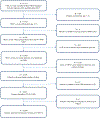Impact of dispatcher-assisted cardiopulmonary resuscitation on performance of termination of resuscitation criteria
- PMID: 34871758
- PMCID: PMC9272777
- DOI: 10.1016/j.resuscitation.2021.11.034
Impact of dispatcher-assisted cardiopulmonary resuscitation on performance of termination of resuscitation criteria
Abstract
Background: Current Advanced Life Support Termination of Resuscitation (TOR) guidelines suggest when to cease cardiopulmonary resuscitation (CPR). With the significant increase of Dispatch-Assisted CPR (DA-CPR) programs, the impact of DA-CPR on the TOR criteria performance is not clear.
Methods: We conducted a secondary analysis of a prospectively collected registry, the Pan-Asian Resuscitation Outcomes Study. We included patients >15 years old with out-of-hospital cardiac arrest between 2014 and 2017 (after implementation of Singapore's DA-CPR program). We excluded patients with non-cardiac etiology, known do-not-resuscitate status, and healthcare provider bystanders. All cases were collected in accordance to Utstein standards. We evaluated the addition of DA-CPR to the diagnostic performance of TOR criteria using logistic regression modeling. The primary outcome was performance for predicting non-survival at 30 days. Sensitivity, specificity, and positive and negative predictive values were calculated.
Results: Of the 6009 cases, 319 (5.3%) were still alive at 30 days. Patients had a mean age of 67.9 (standard deviation 15.7) years and were mostly male and Chinese. Almost half of patients had no bystander CPR. The TOR criteria differentiating DA-CPR from unassisted bystander CPR has a specificity of 94% and predictive value of death of 99%, which was not significantly different from undifferentiated CPR criteria. There were differences in adjusted association with survival between unassisted and DA-CPR.
Conclusion: Advanced life support TOR criteria retain high specificity and predictive value of death in the context of DA-CPR. Further research should explore the differences between unassisted CPR and DA-CPR to understand differential survival outcomes.
Keywords: Cardiac arrest; Cardiopulmonary resuscitation; Circulation return; Emergency medical services; Resuscitation; Spontaneous.
Copyright © 2021 Elsevier B.V. All rights reserved.
Figures
References
-
- Suchard JR, Fenton FR, Powers RD. Medicare expenditures on unsuccessful out-of-hospital resuscitations. The Journal of emergency medicine. 1999;17:801–5. - PubMed
-
- Schneiderman LJ, Jecker NS, Jonsen AR. Medical futility: its meaning and ethical implications. American College of Physicians; 1990. - PubMed
-
- Morrison LJ, Verbeek PR, Zhan C, Kiss A, Allan KS. Validation of a universal prehospital termination of resuscitation clinical prediction rule for advanced and basic life support providers. Resuscitation. 2009;80:324–8. - PubMed
-
- Mao DRH, Ong MEH, Bang C, Salim MDT, Ng YY, Lie DA. Psychological Comfort of Paramedics with Field Death Pronouncement: A National Asian Study to Prepare Paramedics for Field Termination of Resuscitation. Prehospital emergency care. 2018;22:260–5. - PubMed
-
- Nolan JP, Maconochie I, Soar J, Olasveengen TM, Greif R, Wyckoff MH, et al. Executive Summary: 2020 International Consensus on Cardiopulmonary Resuscitation and Emergency Cardiovascular Care Science With Treatment Recommendations. Circulation. 2020;142:S2–S27. - PubMed
Publication types
MeSH terms
Grants and funding
LinkOut - more resources
Full Text Sources
Medical


